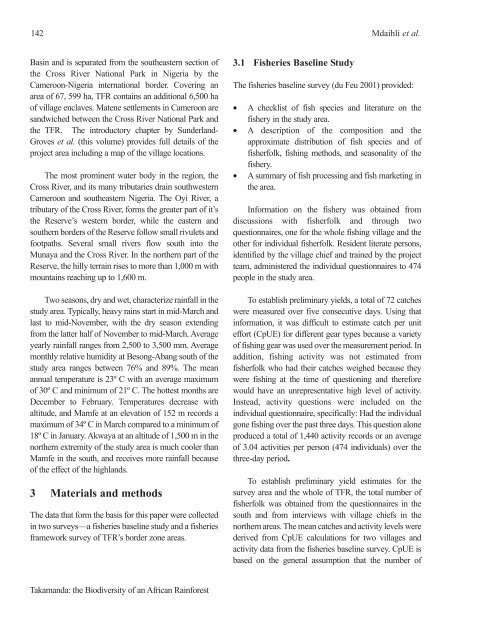Fisheries in the Southern Border Zone of Takamanda - Impact ...
Fisheries in the Southern Border Zone of Takamanda - Impact ...
Fisheries in the Southern Border Zone of Takamanda - Impact ...
You also want an ePaper? Increase the reach of your titles
YUMPU automatically turns print PDFs into web optimized ePapers that Google loves.
142 Mdaihli et al.<br />
Bas<strong>in</strong> and is separated from <strong>the</strong> sou<strong>the</strong>astern section <strong>of</strong><br />
<strong>the</strong> Cross River National Park <strong>in</strong> Nigeria by <strong>the</strong><br />
Cameroon-Nigeria <strong>in</strong>ternational border. Cover<strong>in</strong>g an<br />
area <strong>of</strong> 67, 599 ha, TFR conta<strong>in</strong>s an additional 6,500 ha<br />
<strong>of</strong> village enclaves. Matene settlements <strong>in</strong> Cameroon are<br />
sandwiched between <strong>the</strong> Cross River National Park and<br />
<strong>the</strong> TFR. The <strong>in</strong>troductory chapter by Sunderland-<br />
Groves et al. (this volume) provides full details <strong>of</strong> <strong>the</strong><br />
project area <strong>in</strong>clud<strong>in</strong>g a map <strong>of</strong> <strong>the</strong> village locations.<br />
The most prom<strong>in</strong>ent water body <strong>in</strong> <strong>the</strong> region, <strong>the</strong><br />
Cross River, and its many tributaries dra<strong>in</strong> southwestern<br />
Cameroon and sou<strong>the</strong>astern Nigeria. The Oyi River, a<br />
tributary <strong>of</strong> <strong>the</strong> Cross River, forms <strong>the</strong> greater part <strong>of</strong> it’s<br />
<strong>the</strong> Reserve’s western border, while <strong>the</strong> eastern and<br />
sou<strong>the</strong>rn borders <strong>of</strong> <strong>the</strong> Reserve follow small rivulets and<br />
footpaths. Several small rivers flow south <strong>in</strong>to <strong>the</strong><br />
Munaya and <strong>the</strong> Cross River. In <strong>the</strong> nor<strong>the</strong>rn part <strong>of</strong> <strong>the</strong><br />
Reserve, <strong>the</strong> hilly terra<strong>in</strong> rises to more than 1,000 m with<br />
mounta<strong>in</strong>s reach<strong>in</strong>g up to 1,600 m.<br />
Two seasons, dry and wet, characterize ra<strong>in</strong>fall <strong>in</strong> <strong>the</strong><br />
study area. Typically, heavy ra<strong>in</strong>s start <strong>in</strong> mid-March and<br />
last to mid-November, with <strong>the</strong> dry season extend<strong>in</strong>g<br />
from <strong>the</strong> latter half <strong>of</strong> November to mid-March. Average<br />
yearly ra<strong>in</strong>fall ranges from 2,500 to 3,500 mm. Average<br />
monthly relative humidity at Besong-Abang south <strong>of</strong> <strong>the</strong><br />
study area ranges between 76% and 89%. The mean<br />
annual temperature is 23º C with an average maximum<br />
<strong>of</strong> 30º C and m<strong>in</strong>imum <strong>of</strong> 21º C. The hottest months are<br />
December to February. Temperatures decrease with<br />
altitude, and Mamfe at an elevation <strong>of</strong> 152 m records a<br />
maximum <strong>of</strong> 34º C <strong>in</strong> March compared to a m<strong>in</strong>imum <strong>of</strong><br />
18º C <strong>in</strong> January. Akwaya at an altitude <strong>of</strong> 1,500 m <strong>in</strong> <strong>the</strong><br />
nor<strong>the</strong>rn extremity <strong>of</strong> <strong>the</strong> study area is much cooler than<br />
Mamfe <strong>in</strong> <strong>the</strong> south, and receives more ra<strong>in</strong>fall because<br />
<strong>of</strong> <strong>the</strong> effect <strong>of</strong> <strong>the</strong> highlands.<br />
3 Materials and methods<br />
The data that form <strong>the</strong> basis for this paper were collected<br />
<strong>in</strong> two surveys—a fisheries basel<strong>in</strong>e study and a fisheries<br />
framework survey <strong>of</strong> TFR’s border zone areas.<br />
<strong>Takamanda</strong>: <strong>the</strong> Biodiversity <strong>of</strong> an African Ra<strong>in</strong>forest<br />
3.1 <strong>Fisheries</strong> Basel<strong>in</strong>e Study<br />
The fisheries basel<strong>in</strong>e survey (du Feu 2001) provided:<br />
• A checklist <strong>of</strong> fish species and literature on <strong>the</strong><br />
fishery <strong>in</strong> <strong>the</strong> study area.<br />
• A description <strong>of</strong> <strong>the</strong> composition and <strong>the</strong><br />
approximate distribution <strong>of</strong> fish species and <strong>of</strong><br />
fisherfolk, fish<strong>in</strong>g methods, and seasonality <strong>of</strong> <strong>the</strong><br />
fishery.<br />
• A summary <strong>of</strong> fish process<strong>in</strong>g and fish market<strong>in</strong>g <strong>in</strong><br />
<strong>the</strong> area.<br />
Information on <strong>the</strong> fishery was obta<strong>in</strong>ed from<br />
discussions with fisherfolk and through two<br />
questionnaires, one for <strong>the</strong> whole fish<strong>in</strong>g village and <strong>the</strong><br />
o<strong>the</strong>r for <strong>in</strong>dividual fisherfolk. Resident literate persons,<br />
identified by <strong>the</strong> village chief and tra<strong>in</strong>ed by <strong>the</strong> project<br />
team, adm<strong>in</strong>istered <strong>the</strong> <strong>in</strong>dividual questionnaires to 474<br />
people <strong>in</strong> <strong>the</strong> study area.<br />
To establish prelim<strong>in</strong>ary yields, a total <strong>of</strong> 72 catches<br />
were measured over five consecutive days. Us<strong>in</strong>g that<br />
<strong>in</strong>formation, it was difficult to estimate catch per unit<br />
effort (CpUE) for different gear types because a variety<br />
<strong>of</strong> fish<strong>in</strong>g gear was used over <strong>the</strong> measurement period. In<br />
addition, fish<strong>in</strong>g activity was not estimated from<br />
fisherfolk who had <strong>the</strong>ir catches weighed because <strong>the</strong>y<br />
were fish<strong>in</strong>g at <strong>the</strong> time <strong>of</strong> question<strong>in</strong>g and <strong>the</strong>refore<br />
would have an unrepresentative high level <strong>of</strong> activity.<br />
Instead, activity questions were <strong>in</strong>cluded on <strong>the</strong><br />
<strong>in</strong>dividual questionnaire, specifically: Had <strong>the</strong> <strong>in</strong>dividual<br />
gone fish<strong>in</strong>g over <strong>the</strong> past three days. This question alone<br />
produced a total <strong>of</strong> 1,440 activity records or an average<br />
<strong>of</strong> 3.04 activities per person (474 <strong>in</strong>dividuals) over <strong>the</strong><br />
three-day period.<br />
To establish prelim<strong>in</strong>ary yield estimates for <strong>the</strong><br />
survey area and <strong>the</strong> whole <strong>of</strong> TFR, <strong>the</strong> total number <strong>of</strong><br />
fisherfolk was obta<strong>in</strong>ed from <strong>the</strong> questionnaires <strong>in</strong> <strong>the</strong><br />
south and from <strong>in</strong>terviews with village chiefs <strong>in</strong> <strong>the</strong><br />
nor<strong>the</strong>rn areas. The mean catches and activity levels were<br />
derived from CpUE calculations for two villages and<br />
activity data from <strong>the</strong> fisheries basel<strong>in</strong>e survey. CpUE is<br />
based on <strong>the</strong> general assumption that <strong>the</strong> number <strong>of</strong>

















